1lumen selects and reviews products personally. We may earn affiliate commissions through our links, which help support our testing.
Sofirn SP36 Pro review
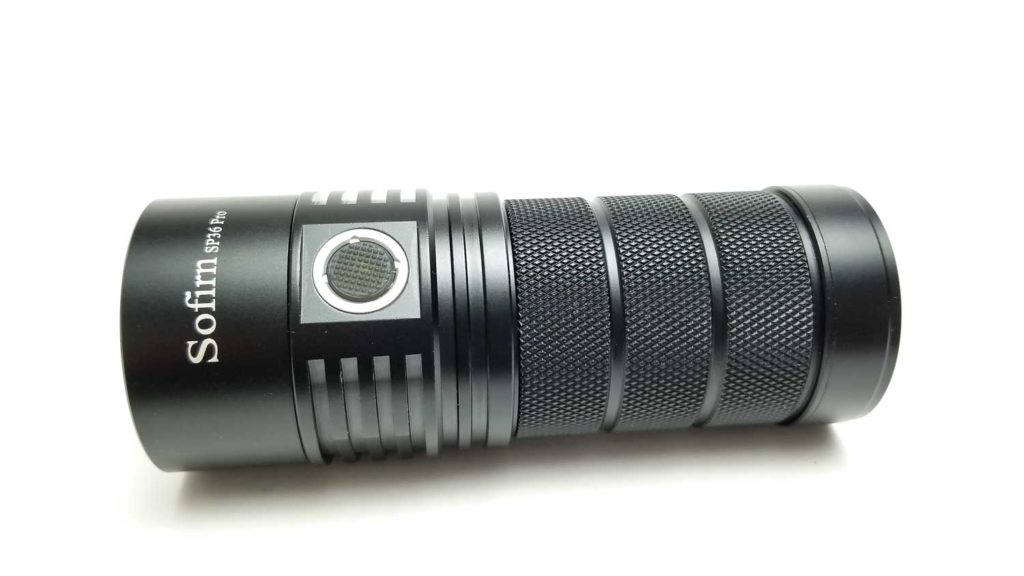
Sofirn SP36 Pro specifications
| Brand/model | Sofirn SP36 Pro |
|---|---|
| LED | 4 x Luminus SST40 |
| Lumens | 8,000 lm |
| Beam intensity | 2,250 cd |
| Battery config. | 3*18650 |
| Material | Aluminum |
| Modes | Many (Anduril) |
| Blinkies | Many (Anduril) |
| Reflector | Quad Smooth reflector |
| Waterproof | IPX8 |
| Review date | July 2021 |
Introduction:
Sofirn knows flashlights, and more importantly, makes good ones at attractive prices, so they’re no stranger to the flashlight enthusiast nexus. They became even more so after assuming production (from Throfire) for the BLF Q8, which was introduced in late 2017 as the do-all, end-all enthusiast flashlight. The Q8 was designed from the beginning with input from enthusiasts from the Budget Light Forum (BLF), and produced by Thorfire. It retained the SkyRay King four 18650 cells and quad emitter format, but was a completely new design with integrated MCPCB shelf, proper FET driver, and a very advanced UI in TomE’s NarsilM. With 4 Cree XP-L HDs (the Sofirn version used the XP-L HI), it could manage 5000+ Lumens, sustain high output, and could be had for around $40 with discounts. Fast-forward to 2019 and enthusiasts were calling for a smaller and more modern version of the Q8. Sofirn, active listener that they are, took the Q8, dropped a battery, added type C onboard charging, and redesigned the body into a more compact form factor.
Voila! The Sofirn SP36 was born. With three 18650’s on board and the same quad emitters (Cree’s infamous XP-L2 this time) it retained the high output (bumped to 6000 Lumens) and decent sustainability for around $50 US (see a trend?). Sofirn followed enthusiast requests and introduced versions featuring ToyKeeper’s Anduril, and a special Sofirn SP36 BLF Edition with Samsung LH351D high CRI emitters, which Owen reviewed. Apparently, Sofirn must be able to read minds (like mine), so they stuck in some Luminus SST40s, put ‘Pro’ on it, and abracadabra; the SP36 Pro was introduced in early 2021. Today I’ll be taking a look at the latest version of the Sofirn SP36 and seeing just how ‘Pro’ it really is.
Package quality.
I own a couple Sofirn lights and let me tell you that Sofirn doesn’t invest heavily in packaging. Like Astrolux, Wurkkos, and Convoy, the boxes are well, pretty much boxes and not much else. The SP36 Pro arrived in a plain, recycled cardboard box with Sofirn on the top, some QR codes on the bottom, and a single sticker with the emitter CCT on it. That’s it. No fanfare or fufu packaging, and that’s fine because it brings the cost down. Besides, unless you’re like me, the boxes get tossed anyway. Inside, the SP36 was wrapped in protective bubble wrap and the bottom of the box was cushioned with foam. No damage whatsoever, so a win for the packaging. Here’s what you get:
- Sofirn SP36 Pro flashlight
- USB A to C charging cable
- 2 spare o-rings
- 3 Sofirn-branded 18650 button top batteries (loaded in the light)
- User manual
The batteries are optional, so if you don’t have 3 matching batteries, it’s a good idea to get the bundled cells since they seem pretty good quality and will be cheaper than buying them separately. This is a nice kit, and with the batteries, is everything you need to get going. The included accessories are high quality, and here’s a tip: Sofirn’s bundled USB cables are some of the best I’ve come across, even better than ‘name brand’ cables I paid too much money for. Bonus! The cells were loaded in the light upside down, but thankfully there was a dark plastic isolator to keep them from shorting out!
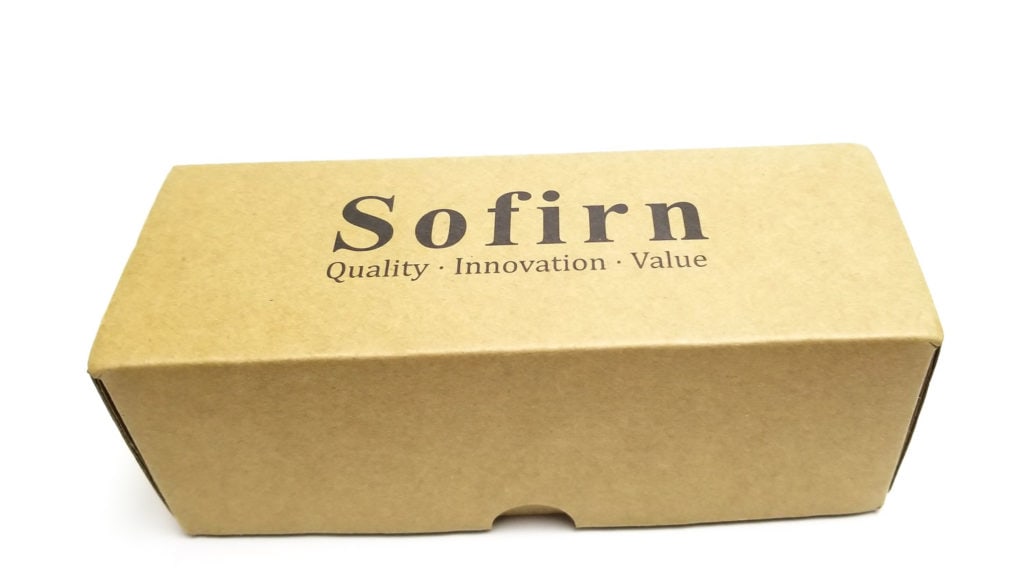
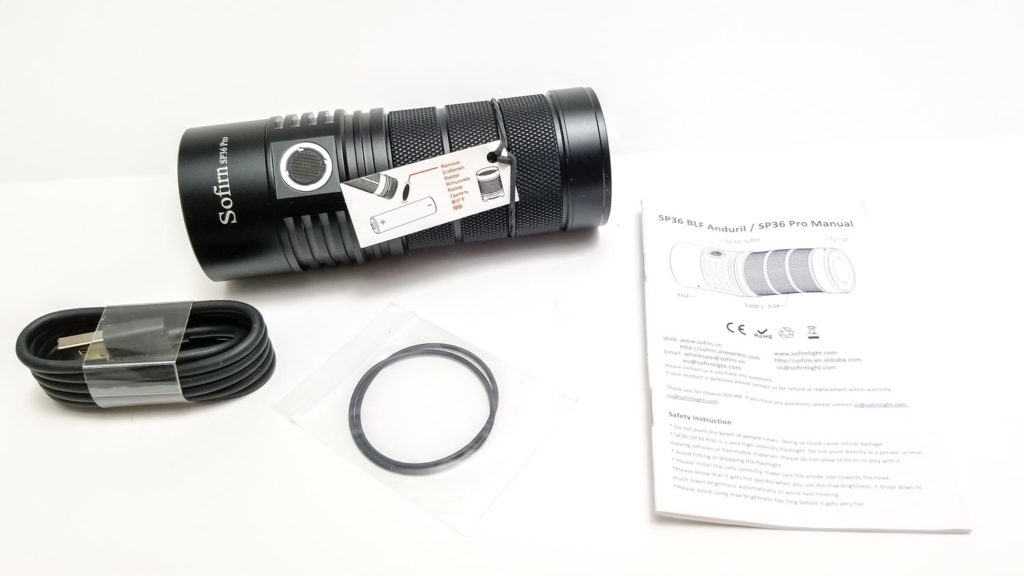
Sofirn SP36 PRO Flashlight in use
The Sofirn SP36, like the Q8, is based on the ‘soda can’ form factor, which is three or four 18650 batteries behind a multi-LED reflector/optic. The SP36 has three 18650 cells in parallel which makes the body a little slimmer than the Q8. It’s not lightweight by any means but is lighter than the Q8, and much lighter than my modded SRK. For comparison, the SRK weighs 355.8 grams without batteries compared to the SP36 Pro at 297.4 grams. Despite the girth and weight, I will say it handles nicely. There’s plenty of gripping surface between the smartly-designed battery tube and generous fins on the head. In addition, the balance point is nearly in the center, and that helps limit hand fatigue during prolonged use. The battery tube is covered in diamond pattern knurling that’s very grippy and nicely cut. No issues with handling, but I have large hands so your mileage may vary.
There’s no lanyard hole or attachment points, so you’re limited to pocket carry, a holster, or pouch. It fits fine in cargo pants or jacket pockets, but smaller pockets would be pretty tight. I would at the very least like to see a means to attach a lanyard (hint, hint, Sofirn). The front e-switch is a real gem, one of the nicer ones I’ve come across. It has a silicone rubber cover that’s really grippy and the click action is nice and positive with just the right amount of travel and great feedback. It’s easy to find by feel as well since it sits a little proud from the side and does have LED indicators for finding in the dark.
Besides the slightly proud charging port cover, there’s no anti-roll cuts anywhere, so nothing to stop it from becoming a rolling stone. Tail standing is no issue at all thanks to the flat tailcap, and with a diffuser stuck on (yep, Sofirn thought of that and sells one for the SP36), it would make an excellent lantern.

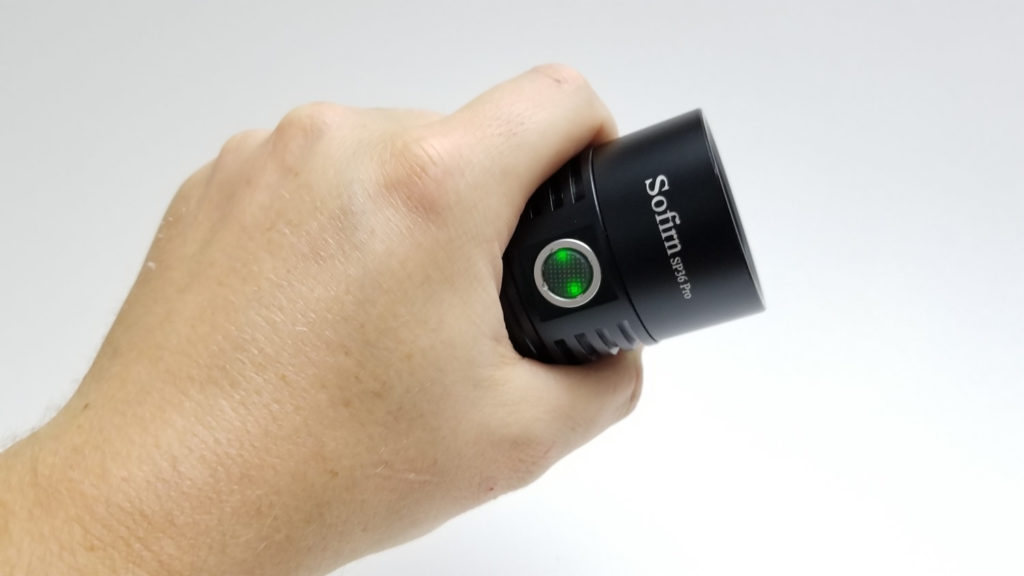
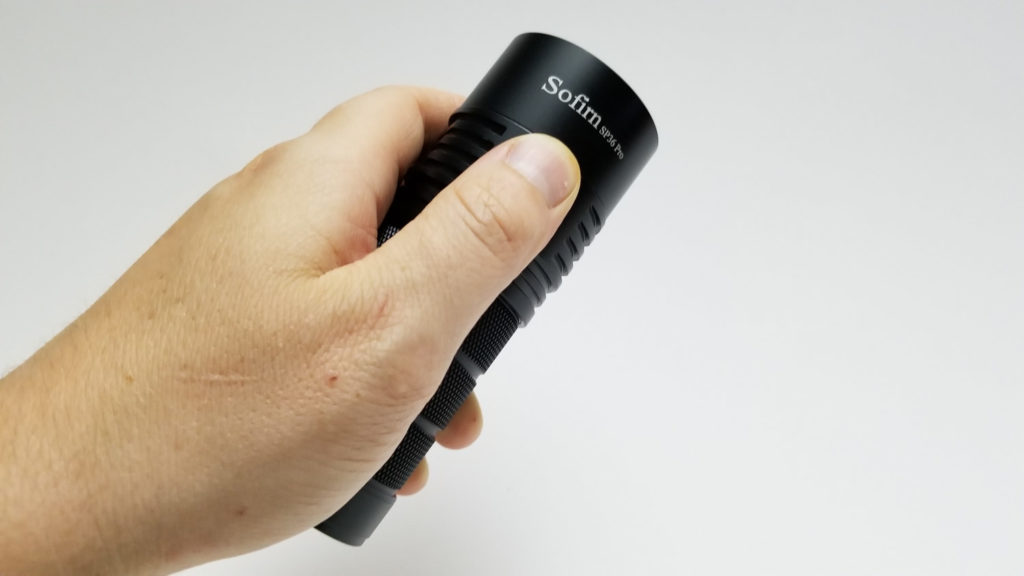
Build Quality, and Warranty
Although I consider Sofirn a budget brand, their lights certainly don’t reflect that. In fact, for the money you really get a nice light. Build quality is perfectly acceptable for the price. It’s not Acebeam or Fenix-level quality for fit and finish, but definitely commensurate for the asking price. The machining is well done, but I can tell where Sofirn left out certain finishing steps to keep costs down. Although most edges are beveled and chamfered, there were some pretty abrupt/mildly sharp edges on the cooling fins and the cutout where the switch is located. Otherwise, there are no major tool marks or machining defects to be found. The parts all fit together and lined up with no gaps or odd angles. The finish is also well done, and it’s the same decently tough semi-gloss type III HA I’m used to from Sofirn, and I didn’t notice any bare spots, knicks, dings, or coverage issues.
Just like the Q8, the SP36 Pro can be easily disassembled, and this is what sets a true enthusiast light apart from a consumer grade flashlight. The bezel, tailcap, tail spring PCB, battery tube, reflector, MCPCB, driver, and switch PCB are all easily accessible and removable. I had no trouble unscrewing the bezel, and getting the driver out is as easy as screwing the switch button bezel with some needle nose pliers or snap ring pliers and finagling out the switch PCB. Although the driver and switch PCB are held on with a little bit of weak glue, it’s not hard to defeat and everything else comes apart without much effort.
The reflector is held to the integrated shelf by some screws, and the MCPCB is also screwed down for an excellent thermal interface. The LED’s can be swapped for any 5050-size emitter (hmmm, SFT-40-W, XHP50.2 perhaps?), you can tweak or replace the driver, bypass the tail springs, change the front lens, etc. The springs in the tail are gold-plated and decently thick, but this light doesn’t pull high amps from a single cell due to the parallel configuration, so thick springs aren’t needed. The driver-side has a brass ring for the positive battery contact. The threads are very nice rectangular cut deals and look very durable. They were adequately lubed also and pretty smooth. Accessibility sometimes comes at an ingress protection penalty, but Sofirn puts o-rings in all the right places: One sealing the tailcap, one sealing the head to the battery tube, and two in the bezel. The silicone rubber flap sealing the USB port is nice and tight, and I noticed it made a pfftt noise when opening it up after replacing the battery tube (nice hiss). Yep, it’s sealed nicely. Sofirn gives the SP36 an IPX8 rating, so it should be good for temporary immersion at the least.
Warranty? Sofirn’s warranty is pretty decent. From Sofirnlight.com: If your Sofirn product has any defect as the result of the materials or workmanship we want to make it right! Within 30 days of purchase: Contact the original seller for repair or replacement. Within 2 years of purchase: Contact Sofirn for repair or replacement. This warranty does not cover normal wear and tear, modifications, misuse, disintegrations, negligence, accidents, improper maintenance, or repair by anyone other than an Authorized retailer or Sofirn itself. Batteries are currently under a 1 year warranty.
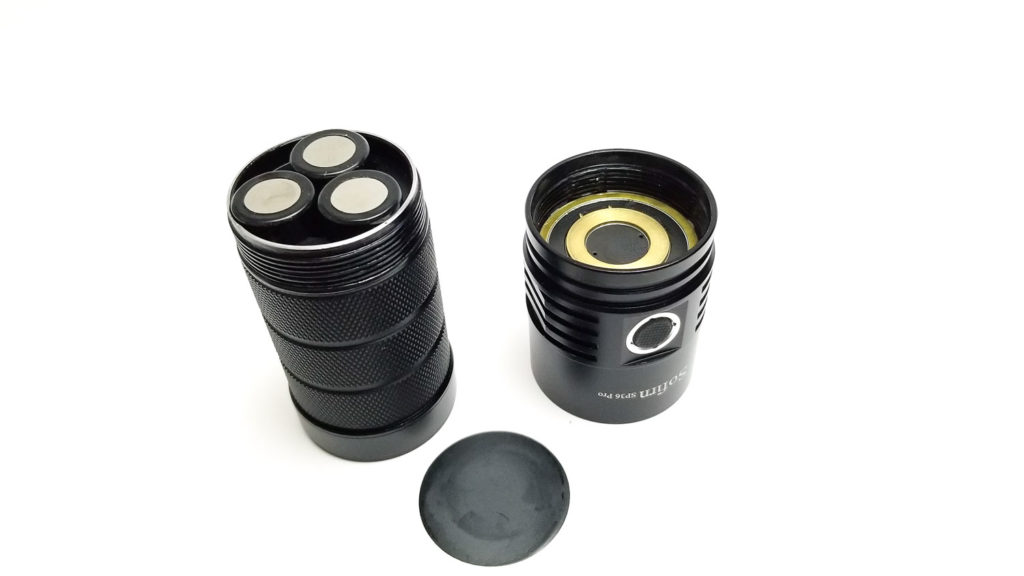
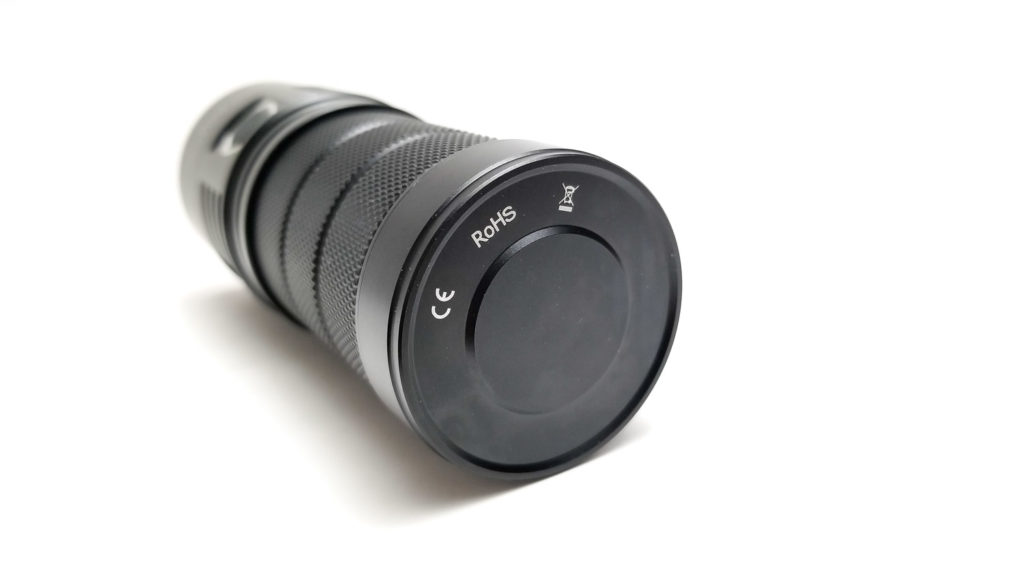
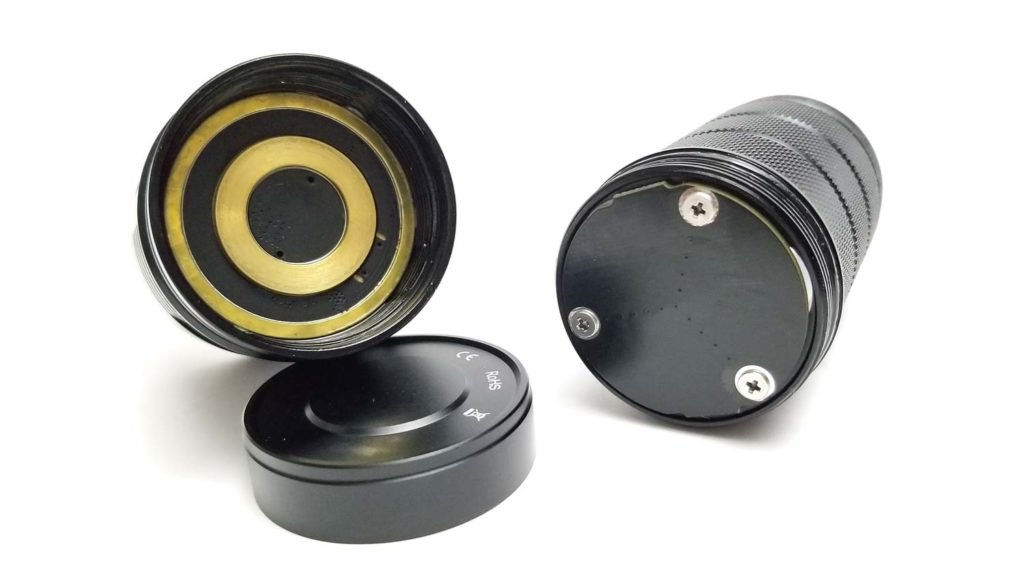
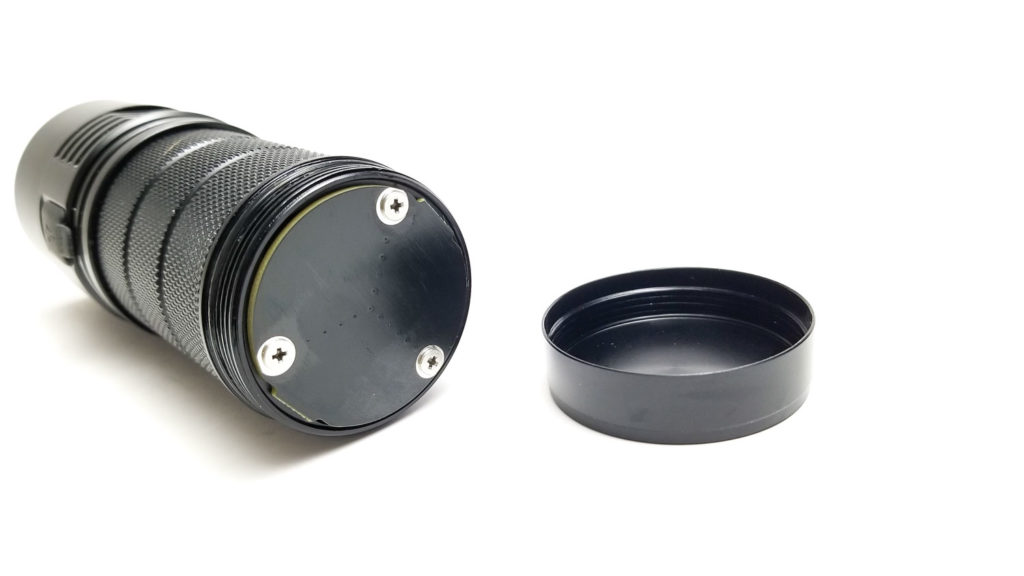
LED, Lens, Bezel, and Reflector
As mentioned previously, the SP36 is a quad emitter light. The original featured Cree XP-L2 emitters in roughly 5300-5700K. They were great for output, but suffered from tint shift and the typical gen 2 Cree corona. The later editions replaced the XP-L2 with Samsung LH351D emitters (in 2700, 4000, and 5000K up to 90 CRI), which took the beam quality to another level for a reflector-based multi-emitter light. The Pro version swaps the Samsungs and Crees for the Luminus SST40. This is a 5050-footprint 3 volt LED with a low forward voltage and is capable of very high output and decent beam quality. The SST40’s are available in 5000 or 6500K CCT’s. My sample features the 5000K variety.
The LEDs are perfectly centered in their respective reflector cups in the flawless quad SMO (smooth) reflector array. It’s topped with a decently thick toughened mineral glass lens with AR coating. It’s set a few millimeters behind the non-crenulated bezel for protection from drops.
The beam is about what I expected, with the typical quad reflector “flower petal” shape, but it’s not at all obtrusive and only noticeable up close on white walls. What I did find obtrusive was the bright ring artifact around the inner part of the spill, which kind of mucked up the otherwise nice beam since it’s very obvious no matter what you’re illuminating. The beam itself looks a lot like the beam from my modded SkyRay King with (you guessed it) quad SST40s. There’s a defined hotspot and decent throw with generous spill. Overall this is an extremely useful beam that I think is suitable for any task. The 5000K emitters aren’t high CRI by any means, but still make for a nice beam (aside from the artifact and some subtle green at very low output).
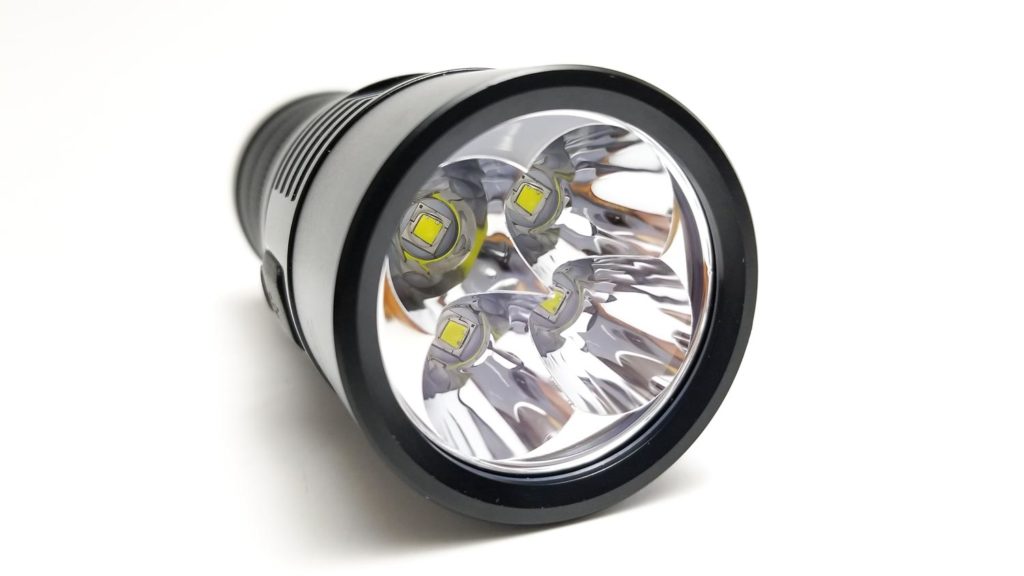
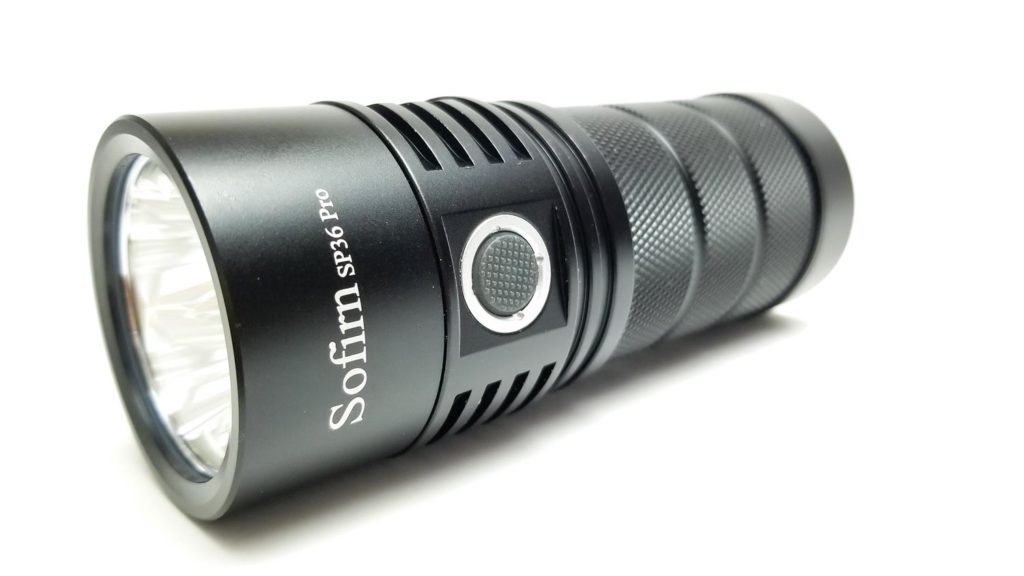
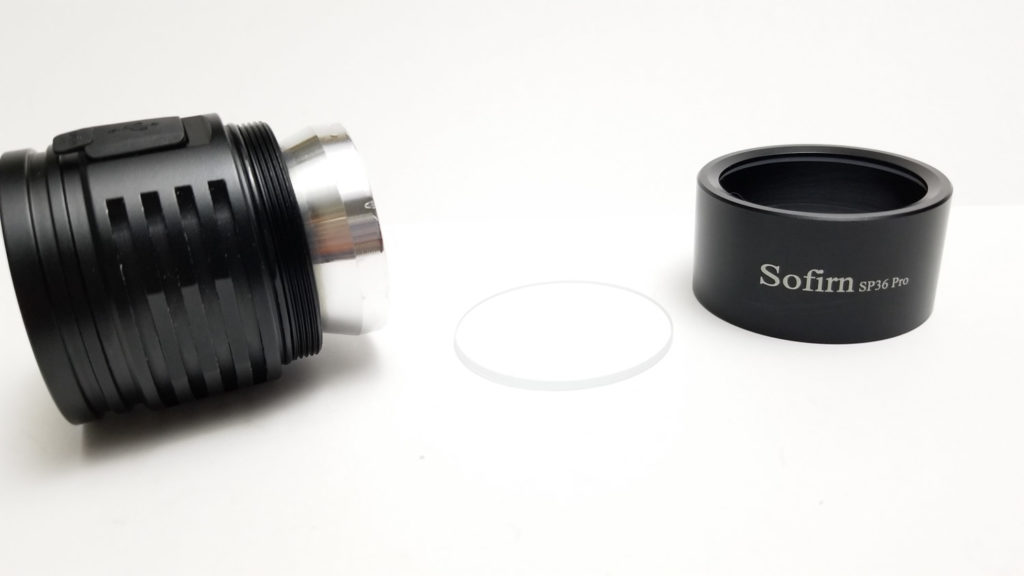
Dimensions and size comparison
- Head diameter: 5.0 cm / 1.96 inches
- Overall length: 12.67 cm / 4.98 inches
Weight:
- Without batteries: 297.4 grams / 10.49 oz.
- With three 3000 mAh 18650 cells: 436.6 grams / 15.4 oz.
Flashlight size comparison
Group 1 left to right: Imalent R30C, Sofirn SP36 Pro, Astrolux FT02S, Thorfire C8.
Group 2 left to right: Sofirn SP36 PRO, Skyray King
Group 3 left to right: SkyRay King, Sofirn SP36 Pro, 12 oz. can of soda.
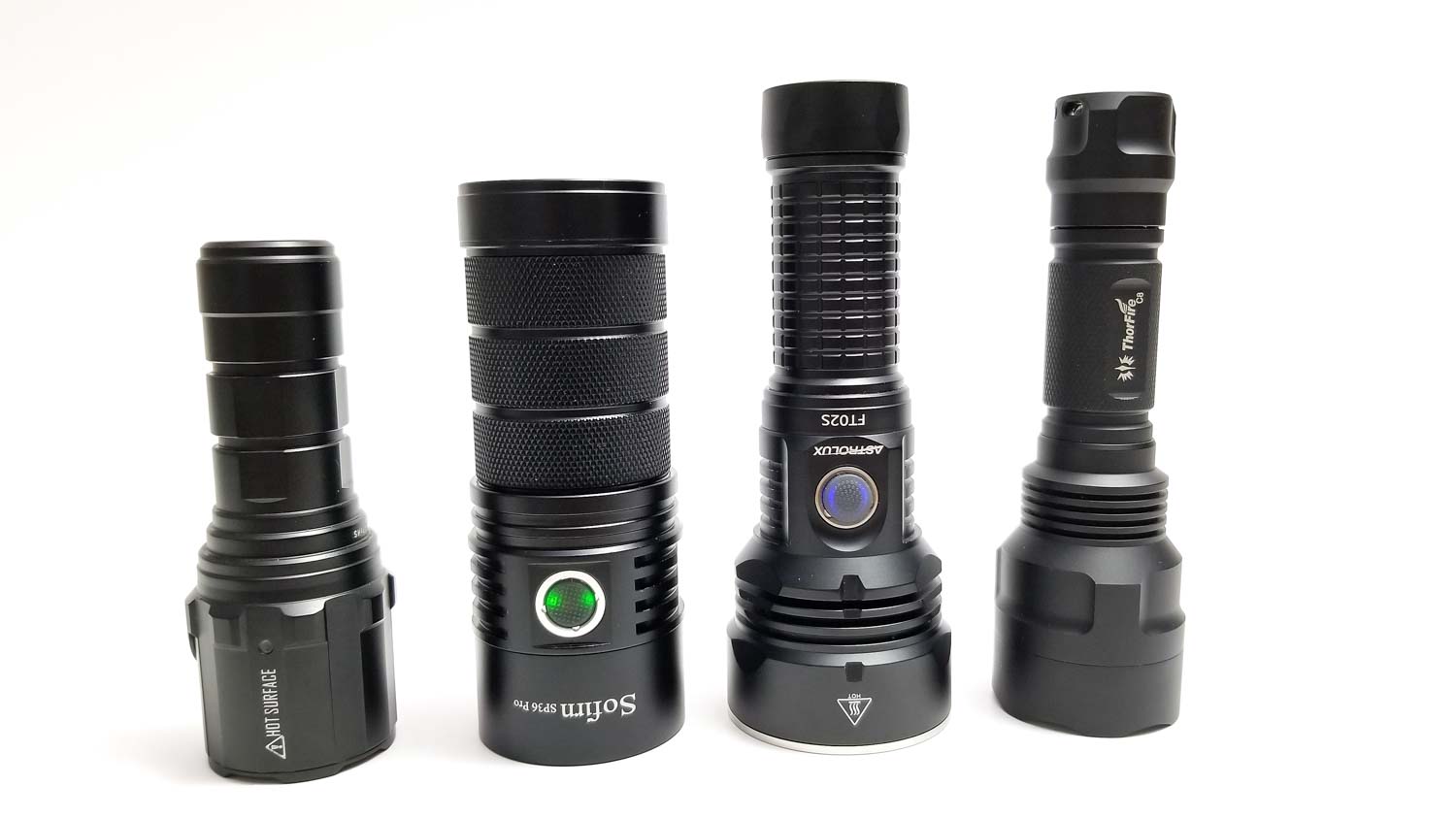
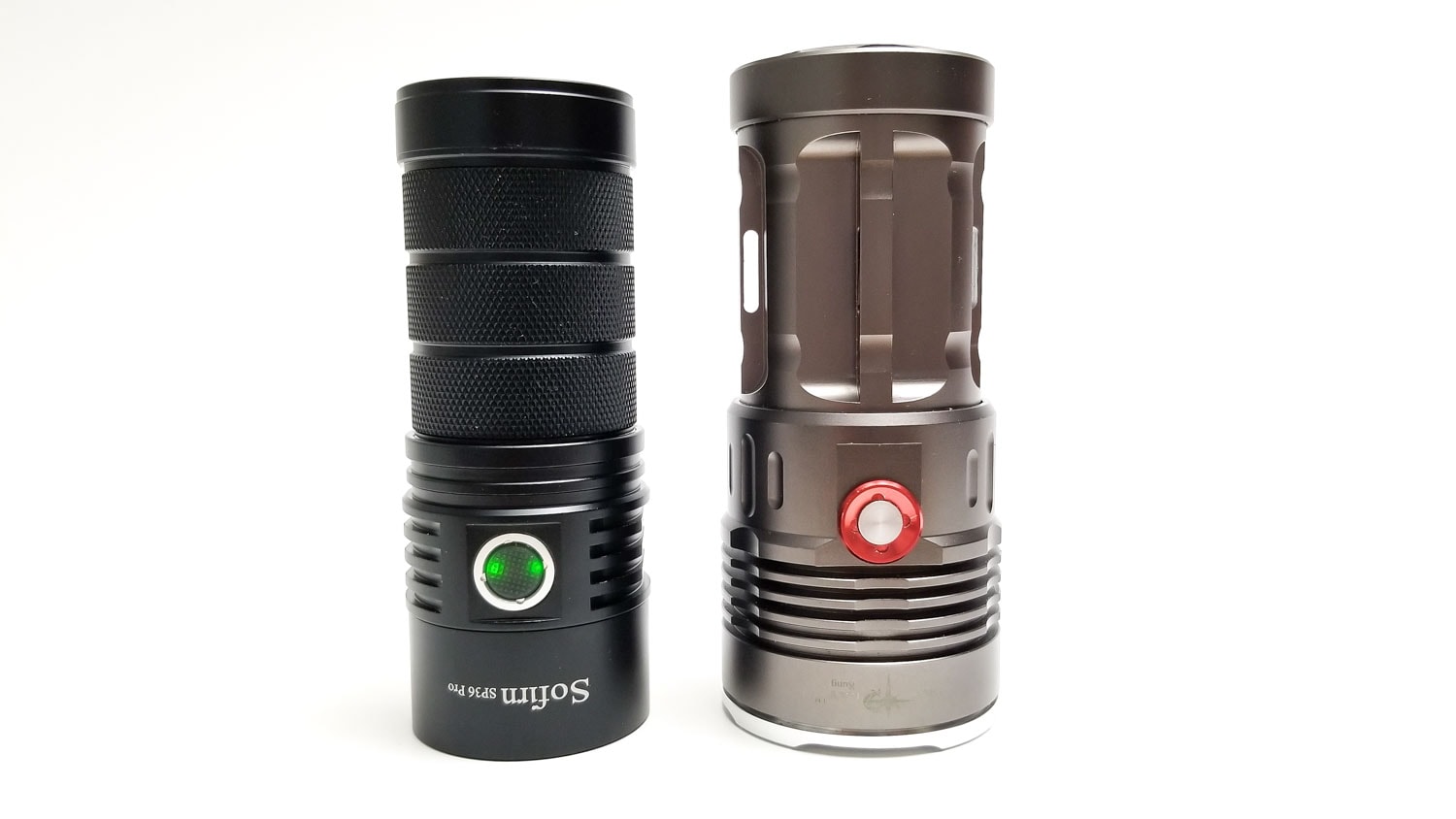


Driver & User Interface:
The SP36 uses the same FET+7135 driver as the SP36 BLF Aduril Edition, so performance is largely dependent on the battery you’re using. High drain batteries will give much higher output, but it will only be noticeable once the FET kicks in in the higher modes (ramping or stepped).
The UI is the familiar Anduril we’ve all come to know and love. This particular model is sporting the 03/18/2020 version (verified with version check- 15 clicks from off…it will blink out the date).
Forthrightly, I am more a fan of simpler UI’s, but once getting used to it, I really enjoy the versatility Anduril offers. There’s tons of modes available, and you can tweak a lot of settings. By default, the UI is set to smooth ramping with instant access to turbo, but you can also opt for stepped ramping with the number of steps and discrete brightness levels being configurable. Other options include a momentary mode for emulating forward clicky action, and a “muggle” mode, which runs the light at a lower output. You also get the mandatory electronic lockout, temperature check, and battery check.
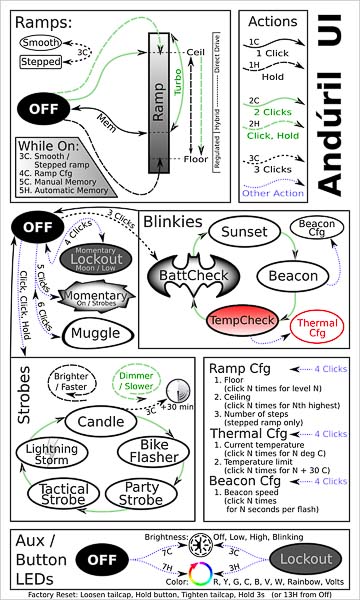
This is the image of the UI, but forget about the bottom part, because this particular light has no AUX LEDs.
From OFF:
- Single-click: ON
- Double click: High (Top of ramp, to get to Turbo, you need to do another double click)
- 3 clicks: Access the blinky/utility modes.
Enter Special/Fun modes from OFF:
- 2 clicks + hold: Strobe modes
- 4 clicks: Lock Out mode
- 5 clicks: Momentary on
- 6 clicks: Muggle mode
From ON:
- Single-click: Off
- Double click: Turbo
- 3 clicks: change ramping mode.. Instead of a smooth increase, it has 6 little steps between Lowest and Max.
- 4 clicks: change to ramping configuration mode
- Press and hold: brightness ramps up.. release and press and hold again to ramp down.
INTERESTING, SPECIAL, AND FUN MODES:
Please read the manual carefully to know how to access or customize these modes. Also see the firmware picture, above.
- Blinky Utility mode:
- Battery check
- Sunset Mode
- Beacon mode
- Temperature check
Strobe / Mood modes:
When in the strobes mode, double-click to rotate between them – all modes except party strobe are brightness, changed the same way as a normal ramp. In party strobe mode, ramping up and down will increase and decrease the frequency of the strobe, for incredible effects.
- Candle
- Bike flasher
- Party strobe
- Tactical Strobe
- Lightning mode
- Lockout mode (can’t use the light)
- Lockout mode is available by clicking four times from off – while in lockout mode, click-and-hold will light up at bottom of the ramp, and a double-click-and-hold will light up somewhat brighter. This is to give you a way to quickly use the light if necessary, but if it activates in your pocket, it will only be at very low modes, and only for as long as the button is pressed. No more holes in pants!
- Momentary mode (signaling/ morse coding)
- Muggle mode: (safer for children)
- Configuration mode
- Ramp config mode
Andruil is a very advanced UI, and can be as easy to use or as complicated as you want it to be. In fact, since Anduril2 has come out with its UI within a UI deal to complicate things, I think a novice could easily learn how to use Anduril quickly. A couple of things to consider though: Check the thermal configuration, since it might be off and this impacts how fast the light throttles back. The thermal calibration was way off for the SP36 Pro by about 15 degrees C, and this has been the case with every Anduril light I’ve reviewed to date. To calibrate the sensor, use a thermometer to check the ambient temperature and make sure the light is more or less equal to that number. Enter the temp check mode by clicking 3 times from off, then double click 3 times to enter the temp check mode. The light will blink a series of blinks that tells you what temperature it thinks it is. If it’s way off from the thermometer, go to the configuration mode (4 more clicks) and set the ambient temperature along with the maximum step down temperature.
LVP works fine and the batteries were discharged down to 2.92 volts after my runtime tests, which is well within the acceptable limit for lithium-ion cells. Once again, well done ToyKeeper!
Batteries & Charging
The original Q8 utilized four 18650 cells in parallel, but the SP36 series makes do with three (also in parallel). The design of the driver is generally conducive to button top cells, and no surprise that Sofirn recommends (and bundles) them. That didn’t stop me from trying some solder-blobbed Sony VTC6 flat top 18650’s and they fit fine. Note that protected cells or ones with integrated charging probably won’t work here due to the length. You wouldn’t need to use protected cells anyway because Anduril has LVP built into the firmware and on turbo you may trip most protection circuits, but nonetheless, I tried a protected button top Acebeam 18650 with USB charging and it was too long at 71 mm.
One of the additions Sofirn made to the SP36 that the Q8 lacked was onboard charging. It’s USB type C and that’s awesome, but in my opinion, it’s more of a convenience feature. Here’s why: At around 1.8 amps according to my USB meter, three 3000 mAh batteries in parallel (9 Ah) will take a long, long time to charge since the charge current is divided between those 3 cells (about 700 mAh after counting for losses in the charging buck circuit). You are better off getting a $10 four-bay charger that does 1 amp per slot, or better yet drop $40 or so on one that does 2 amps or more. I know, I know, most enthusiasts probably already have a charger like that (or two, or three), but I really wish more manufacturers would implement type C PD and QC charging for these high capacity lights (hint, hint, Sofirn and others) since it’s so much faster, but again, it adds complexity and cost, which would raise the price higher and the goal from the get-go was to make a smaller Q8 without raising the price too much. Beggars can’t be choosers, even with flashlights I guess.
Alas, the built-in USB charging works fine, and it took around 4-5 hours to recharge the light after a runtime test on a 2.1 amp wall adapter. The termination voltage was right at 4.20 volts on the nose.
Bonus time! When connected to the charger, the light works, and you have some modes, but expect around 250 Lumens max out of it.
Performance
Sofirn put the SST40’s in the SP36 for a reason, not just to call it “Pro.” I’m expecting good output from this light with high output on the FET and long runtimes on the 7135.
Amp measurement
Measuring the current on this light was an exercise in caution and acrobatics. The best way is using single battery, balancing it on the positive ring of the driver, somehow maneuvering your loop of wire in to make contact with the negative ring on the driver and the negative pole of the battery, all while getting the clamp meter on it without shorting anything out and manipulating the switch. Whew! This is where a third arm and hand would be beneficial. On turbo with the included batteries, I got 11 amps before I gave up. Switching to the VTC6, I got 18.7 amps on turbo.
Runtime graph
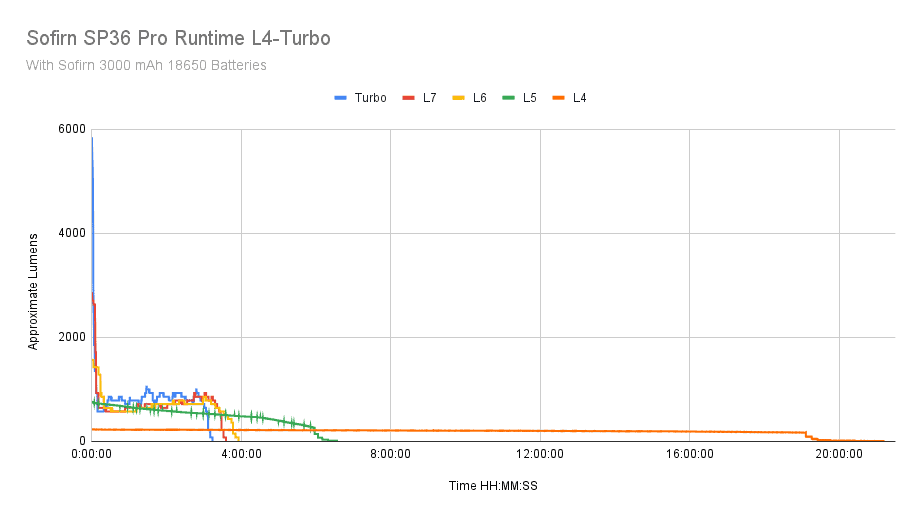
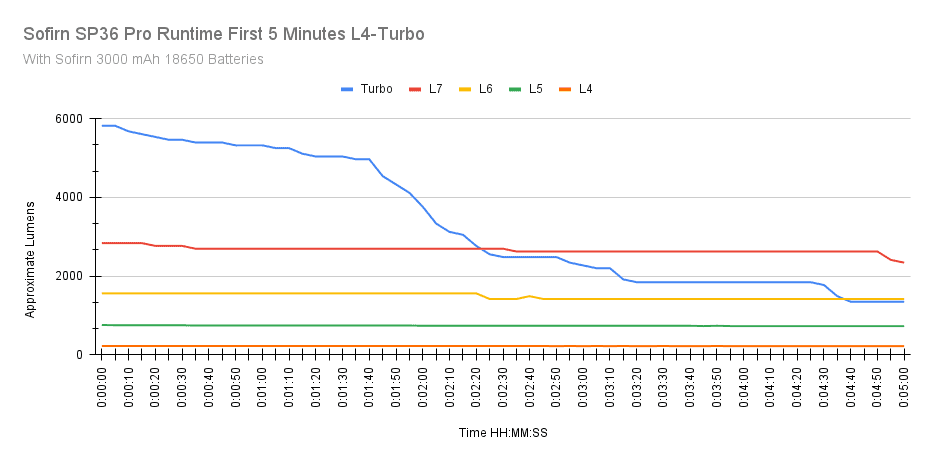
I conducted the runtime test using the 30 centimeter integrating sphere with the Digi-Sense 20250-00 data logging lux meter and tested stepped levels 4, 5, 6, 7, and Turbo. The temperature was calibrated to ambient 23 C and the thermal ceiling set to 60 C. For consistency, I used the fully charged Sofirn-branded 3000 mAh 18650s that came with the light. For all Anduril tests, I end the test when the output drops for the last time because this is technically the LVP and the light will keep running at this low output for a very long time.
Turbo started at a hair over 5800 Lumens, and held that for about 10 seconds before the temperature started rising. Once again, Anduril works its magic with temperature control and starts throttling the output at around 45 seconds. By 60 seconds, the head temperature is 57.4 C and the output is 5325 Lumens. From 60 seconds on, the output is falling, but it’s still over 5000 Lumens at 90 seconds, and over 4000 Lumens at the 115 second mark. At 2 minutes in the head is 56.5 C, but the body is still-hand-friendly 43.8 C. Not bad heat management. By the 5 minute mark, the output is 1349 Lumens, and by 10 minutes it’s down to 568 where it sits for another 9 minutes before throttling back up to 710 Lumens where it sat for a few minutes, then settled at 639 Lumens. At 30 minutes, the output is back up to 852 Lumens, and this behavior continued for the next 2 hours, cresting 1000 Lumens at the 1 hr. 27 minute mark before throttling way down as LVP started kicking in at the 3 hour 10 minute mark when it dropped very low (off the lux meter scale) and I ended the test a short time later. Total runtime (measurable) was 3 hr. 13 minutes.
Level 7 through 5 are nearly identical (aside from higher output), and not surprising since these modes are using the FET on the driver (direct drive) controlled by PWM, so the behavior is similar. As the batteries drain, the output decreases. Level 7 started at 2840 Lumens, and held that for several seconds before a slight decrease to 2769 by 20 seconds. The light heats slowly, only getting above 50 C by the 3 minute mark where the output is over 2600 Lumens. The output doesn’t go below 2000 Lumens until the 5 minute 20 second mark when the temperature is 56.6 C. From there, the output is following Turbo, with the same fluctuations in output as the light heats/cools. The last step down to under 10 Lumens happened at 3 hours 35 minutes, with another drop to under 3 Lumens (which doesn’t register on the graph since the output went below the lux meter scale) at which point I ended the test.
Level 6 started at 1562 Lumens and was pretty consistent with that for over 2 minutes before throttling back to under 1000 Lumens at the 13 minute, 20 second mark. It exhibited the same throttling behavior and held on until 3 hours 55 minutes when the output dropped below 3 Lumens and I ended the test. The highest temperature I observed at 1 hour into the test was 54.2 C. Level 5 is more of the same steadily decreasing output as the batteries drain, albeit at lower output than Level 6. Start was 759 Lumens, steadily dropping in a consistent manner until the 6 hr. 9 minute mark when the output dropped under 50 Lumens, with a final drop to 28, then to 7 Lumens 10 minutes later when I ended the test a short time later 6 hours 33 minutes. Heating was negligible and barely 20C above ambient.
Level 4 was pretty boring, as expected, and no drama whatsoever. The test started at 225.07 Lumens, and held around 222 Lumens for a long time, 30 minutes to be exact, but the output didn’t drop under 200 Lumens for over 9 hours. The output was over 190 Lumens for over 13 hours, finally dropping below 100 Lumens at the 19 hour 6 minute mark. Talk about endurance! I let the test run until the output dropped to under 2 Lumens and I ended the test at the 21 hours and 12 minute mark.
It’s business as usual for the SP36 Pro because it behaves like any FET+1 light running Anduril (FT02S, EA01, EC03, Lumintop FWAA). I am a bit surprised Sofirn doesn’t publish runtime figures because they bundle their own branded cells with the light and testing that wouldn’t be a big deal. Oh well. The thermal performance is quite good, with the nice thermal path, thick shelf, and DTP MCPCB really pulling the heat away from the SST40s. On lower modes, the performance is even better. I have no doubt this light would run for many, many hours on high capacity cells (like the Sanyo 3350 mAh 18650 GA). It will hold high output for long periods, and the thermal regulation is good and the tube stays relatively cool even during long runs on higher modes. Lastly, the light is still usable after the runtime tests at reduced output (around 230 lumens at the top end) which is still plenty bright and won’t leave you in the dark.
Lumen measurements (for each mode)
For the lumen tests, I used my home made 30 cm integrating sphere calibrated with a light of known output using the Digi-Sense 20250-00 data logging lux meter. I used the fully charged included Sofirn branded 3000 mAh 18650s.
| Step | Measured Lumens |
|---|---|
| 1 | 6.39 |
| 2 | 32.66 |
| 3 | 88.75 |
| 4 | 225.07 |
| 5 | 759.70 |
| 6 | 1562 |
| 7 | 2698 (2840 at turn on) |
| Turbo (spec 8000lm) | 5325 (5751 at turn on) |
Sofirn only advertises a single Lumen figure, and I can only assume it’s for Turbo. I didn’t get anywhere near their 8000 Lumen figure (off almost 2300 Lumens), but I know the SST40 is capable of more since the harder you drive it, the better, especially in multi emitter setups. I grabbed 3 married (fully charged) Sony VTC6 and tested the light on Turbo again. The result? How’s 7100 Lumens sound? You could postulate the SP36 Pro is capable of 8000 Lumens, but you need some high-end batteries to do it (and maybe some unicorn pee or pixie dust).
Throw numbers:
Measurements taken at 5 meters indoors using the Uni-t UT383S lux meter. I used the fully charged included Sofirn-branded 3000 mAh 18650 batteries. I tested the 7 stepped modes and Turbo. All readings taken at 30 seconds.
| Step | Measured Throw |
|---|---|
| 1 | N/A- too low |
| 2 | 350 cd, 37.41 m |
| 3 | 950 cd, 61.6 m |
| 4 | 3050 cd, 110.45 m |
| 5 | 7950 cd, 178.32 m |
| 6 | 17,175 cd, 262.10 m |
| 7 | 33,025 cd, 363.45 m |
| Turbo (spec: 429m) | 68,000 cd, 521.53 m |
Sofirn doesn’t list any throw figures in the product description, but there is, however, a “429 meters throwing” blurb on the Sofirn website with no candela number to be found. I obviously got way higher than that, so I’ll take it. Honestly, it’s not surprising for this setup since in my preliminary testing the throw distance is very good.
Beamshots
I tested the SP36 Pro against some other high output lights: Astrolux FT02S (4x XHP50.2, 12k Lumens), Wurkkos DL70 (4x XHP50.2, 13k Lumens), Imalent R30C (3x SST70, 8000 Lumens), Astrolux EC03 (3x SST40, 5100 Lumens). I threw in the (unmodified) SRK and it has the blues (literally)/ At around 2300 Lumens (4X XM-L U2 bin) against the modern lights, it struggles.
The fence is about 95 meters away. This is a good illustration of the beam characteristics each multi-emitter setup has. The SP36 Pro has a pretty “messy” beam.

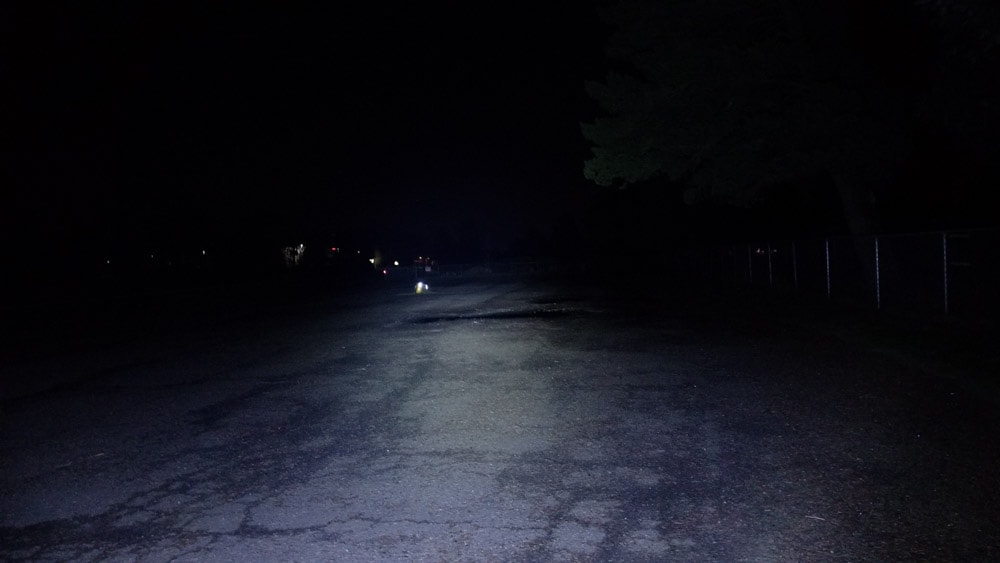
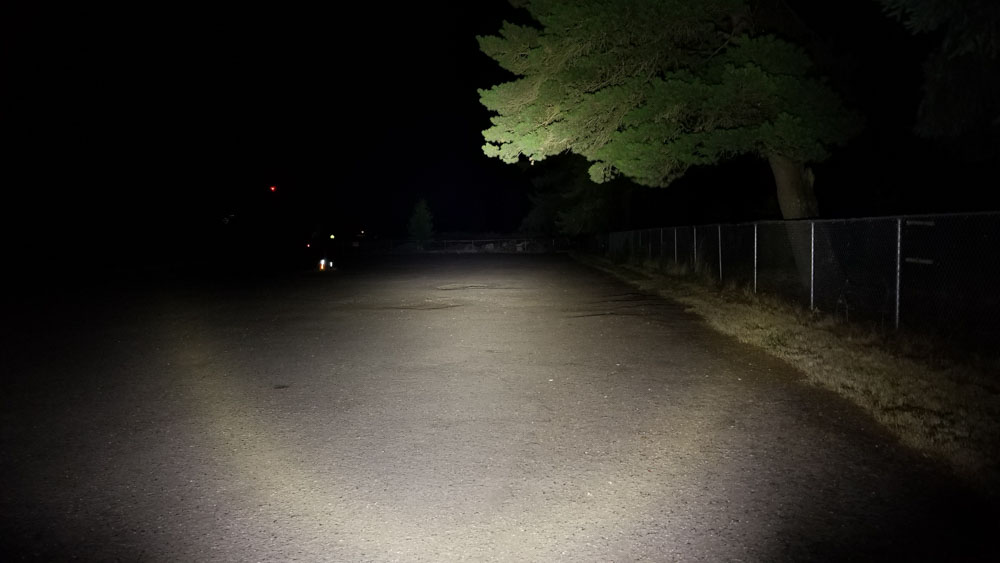
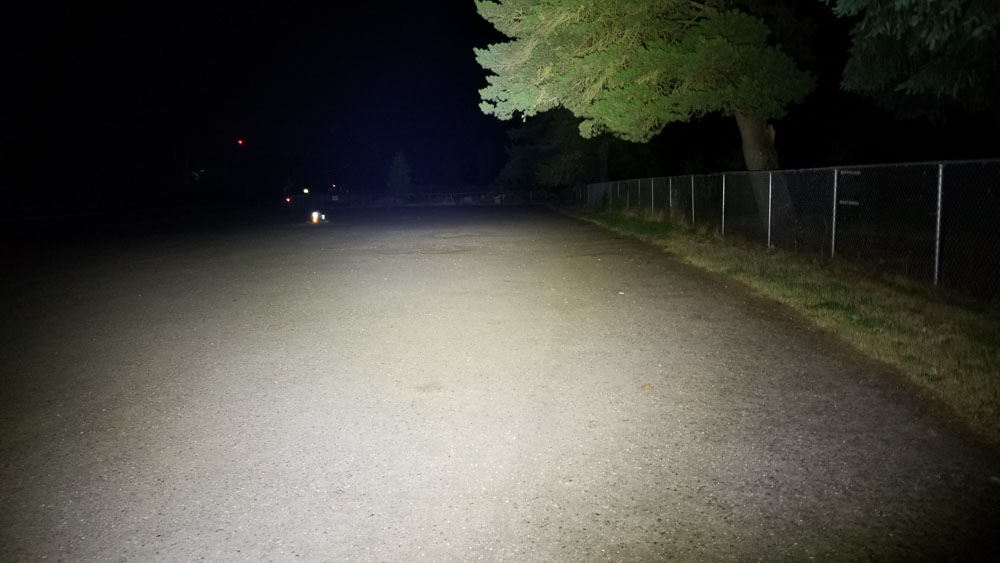
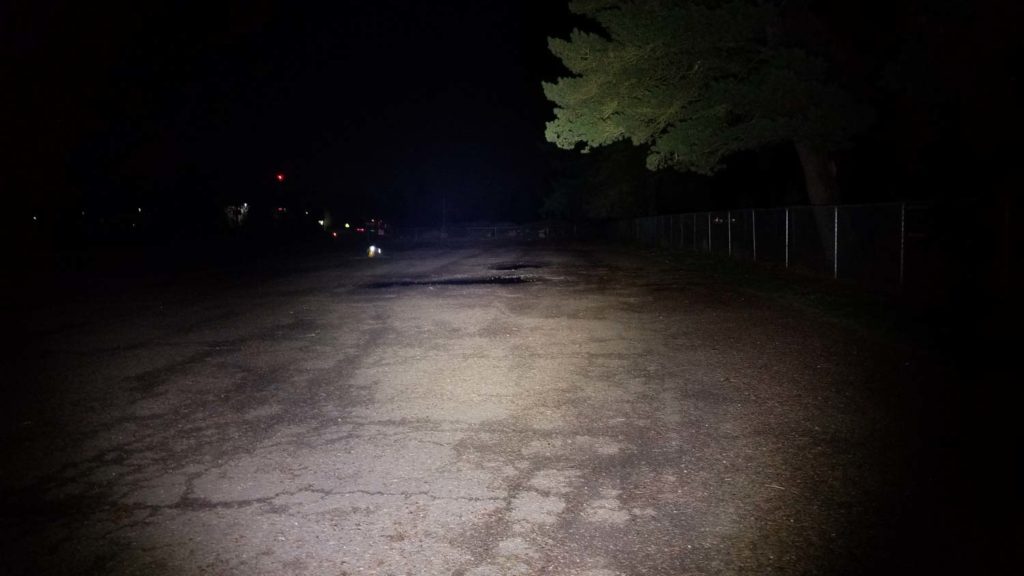
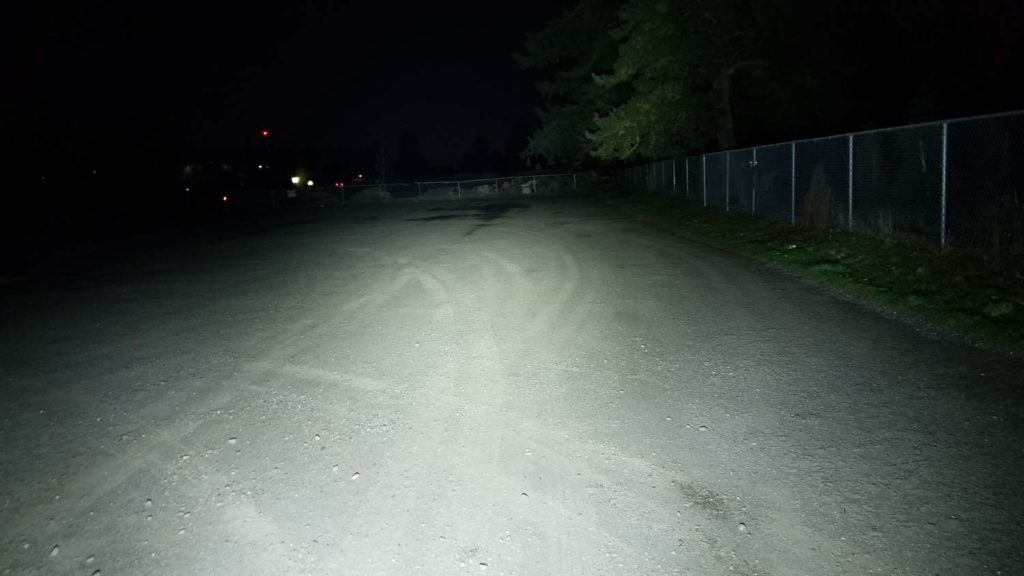
Disclaimer: I bought this flashlight with my own money. Nobody paid me to review this flashlight, nor have I been holding back on problems or defects.
Final Verdict
Pros
- Decent quality and well made
- Compact and easy to handle
- Great throw and versatile beam
- Long runtimes
- Easy to disassemble and mod
- Anduril UI
Cons
- Artifact-ridden beam
- Didn’t reach the specified output
- Thermal calibration was off
- Some sharp edges
- No lanyard attachment points
- Slow charging
Explanation on star ratings:
1: Avoid: my phone flashlight would be a better choice – 2: Poor: significant defect or issues, much better options available at the same price – 3: Average: some defects or issues – 4: Good: recommended (minor issues) – 5: Great: highly recommended

4.5 stars: ★★★★⋆
Before I wrap up this review, let’s go back in time a bit. Before the Thorfire/Sofirn Q8, if you wanted a high output soda-can style light for cheap, you were stuck with the many iterations of the SkyRay King/Kungs, and although some were fairly decent, they all had issues with poor thermal performance, fake emitters, and rudimentary UI’s. Unless you could mod, knew someone who could, or had disposable income to spend on flashlight stuff, they were really the only budget option. The Q8 wasn’t the first multi emitter light to generate a lot of Lumens in a relatively small host, but it was the first to do it reliably at a very affordable price (often under $50). This kind of performance at that price was unheard of in 2017, so yah, the Q8 was extremely important for the enthusiast market, another Genesis light really, the progenitor of an entire market of affordable high powered lights.
I like the SP36 Pro a lot, and it takes me back a ways because a SkyRay Kung was among the first real flashlights I owned. I swapped out the old XM-Ls for SST40s, added copper and aluminum plates to the screw-in shelf, a big brass screw to hold the reflector, and lots of thermal paste. Lastly, I swapped the old 2 mode FET driver with a Mountain Electronics SRK driver. However, even after all that, it’s still not as nice as an off-the-shelf SP36 Pro. So even if you don’t mod, Sofin has you covered.
They really did their homework when designing the SP36, built on the experience and feedback from enthusiasts, and it’s continually evolved over the last few years into a highly versatile light. Want more throw? Swap in the XP-L Hi, (or SFT-40s). Need 11,000 Lumens? Reflow some XHP50.2 3 volts. Don’t like Anduril 3-18-2020? if you have the skill, flash another Attiny85 compatible UI on there. Lots of options. It’s well-made, has convenient USB C charging, decent output, nice handling, and it’s pretty versatile to boot, with long runtimes and good thermal management (once calibrated properly).
I can’t really bash the light too hard for the machining/finishing oversights since it keeps the price down, but is worth mentioning. The bigger issues are there’s nowhere to attach a lanyard, the beam has blatant anomalies, and the output with the included batteries is down…a lot. The thermal calibration was off quite a bit also, and a novice user might have trouble managing that (and other Anduril-isms), but overall, the SP36 Pro does and embodies everything we loved about the Q8 in a smaller package. 4.5 stars.
Sofirn SP36 PRO for sale here:
1lumen selects and reviews products personally. We may earn affiliate commissions through our links, which help support our testing.